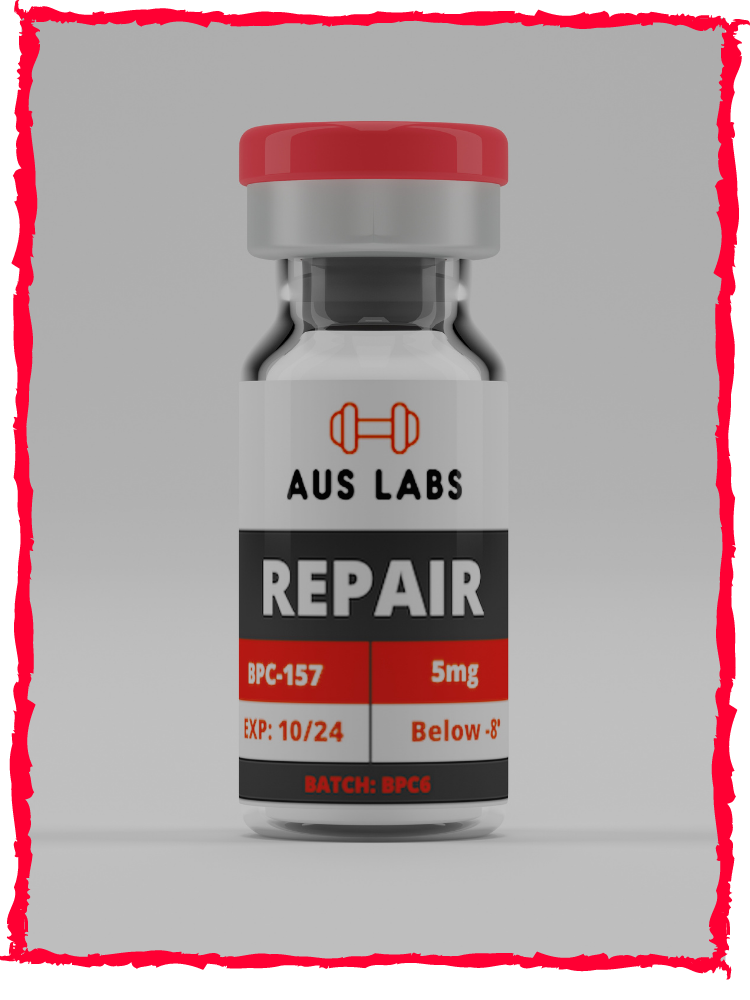Description
REPAIR (BPC 157), composed of 15 amino acids, is a partial sequence of body protection compound (BPC) that is discovered in and isolated from human gastric juice. Experimentally it has been demonstrated to accelerate the healing of many different wounds, including tendon-to-bone healing and superior healing of damaged ligaments.
In addition, REPAIR (BPC 157) seems to protect organs and to prevent ulcers of the stomach. This peptide is also shown to decrease pain in damaged areas. Those who su er from discomfort due to muscle sprains, tears and damage may benefit from treatment with this peptide. It can also help aid skin burns to heal at a faster rate and increase blood flow to damaged tissues.
Human BPC 157) is found in the gastric juice. Experiments have shown that REAPIR (BPC-157) enhances the healing of wounds, including tendons wounds such as transected Achilles tendons of rats. The aim of this study was to investigate the probable mechanism that REAPIR (BPC-157) utilizes to accelerate the healing process in an injured tendon.
The study used two group of tendon explants of which one group was cultured in a REAPIR (BPC-157) -containing medium while the other group was cultured in a medium lacking REPAIR (BPC 157). These cultures were thereafter examined for tendon fibroblasts outgrowths. Such outgrowths indicated tendon regeneration.The results revealed that the explants’ outgrowth was significantly accelerated in the culture containing REAPIR (BPC-157) as compared to the culture lacking REAPIR (BPC-157).
Thus, it can be concluded that REAPIR (BPC-157) enhances the ex-vivo growth and in-vitro cellular migration (assists healing). Moreover, REAPIR (BPC-157) also increases the probability of a cell surviving under oxidative stress.
Dosage
ALL REFERENCES OF USE ARE FOR RESEARCH SUBJECTS AND NOT HUMANS
The reconstitution of the REPAIR (BPC-157) is fast and simple. Popping the cap off of the vial is the very first step. However, it is very important to wipe the stopper with alcohol swab, letting it dry for a few seconds, and do the same thing with the bacteriostatic water vial, and then dose out the corresponding amount of bacteriostatic water, slowly putting in the needle. Inject the bacteriostatic water, ensuring not to inject on the peptide powder indirectly. This reconstitution procedure involves 2ml of water with an overall 2 whole 1ml/1cc insulin syringes.
In order to get the optimum results, using about 200mcg is ideal. This should serve as a medium dose for up to 500mcg. The necessary dose is based mainly on the severity of the wound or injury. In very severe cases, it is proper to dose twice a day, at 350mcg, totaling to 700mcg per day.
According to clinical trials, studies, and user testimonies, the use of this substance can run for four weeks, and then followed by two weeks of rest period. If there are still problems with the specific body parts, the BPC 157 is safe to re-run for another course of four weeks, until wounds are completely healed.
Ingredients
REPAIR: 5mg of Booly protection compound 15; L-Valine, glycyl-L-alpha-glutamyl-L-prolyl-L-prolyl-L-prolylglycyl-L-lysyl-L-prolyl-L-alanyl-L-alpha-aspartyl-L-alpha-aspartyl-L-alanylglycyl-L-leucyl
Storage
Below -20 degrees or the freezer. Once reconstituted -8 degrees or the fridge is acceptable.
Medical References
- Vukojevic, J, Vrdoljak, B, Malekinusic, D, Siroglavic, M, Milavic, M, Kolenc, D, Boban Blagaic, A, Batelja, L, Drmic, D, Seiverth, S & Sikiric, P n.d., ‘The effect of pentadecapeptide BPC 157 on hippocampal ischemia/reperfusion injuries in rats’, BRAIN AND BEHAVIOR
- Darko Perovic, Danijela Kolenc, Vide Bilic, Nenad Somun, Domagoj Drmic, Esmat Elabjer, Gojko Buljat, Sven Seiwerth & Predrag Sikiric 2019, ‘Stable gastric pentadecapeptide BPC 157 can improve the healing course of spinal cord injury and lead to functional recovery in rats’, Journal of Orthopaedic Surgery and Research, vol. 14, no. 1, pp. 1–12
- Masnec, S, Kokot, A, Zlatar, M, Kalauz, M, Kunjko, K, Radic, B, Klicek, R, Drmic, D, Lazic, R, Brcic, L, Radic, R, Ivekovic, R, Seiwerth, S & Sikiric, P 2015, ‘Perforating corneal injury in rat and pentadecapeptide BPC 157’, Experimental Eye Research, vol. 136, pp. 9–15
No statements made on this page have been evaluated by the Bundesministerium für Gesundheit (BMG) or the Therapeutic Goods Administration (TGA). These products are not intended to treat, cure or prevent any disease or illness. All products are strictly for research purposes only. Please refer to the TERMS OF USE for more information.

